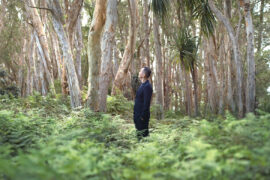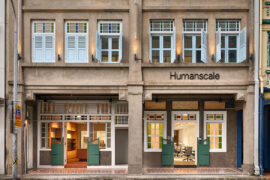Design consultancy COLOURS tears down the architecture and public space silos to create meaningful places for people and the environment.

Apart from its transitional existence, can public spaces such as void decks or walkways be places of value, created in collaboration with the community? This is something that Dr Chong Keng Hua and Kang Fong Ing began considering after experiencing forward- looking design cultures abroad as young professionals amid the recession in the early 2000s. With the different crises that humanity is facing today, what can architects and designers bring to the table?
Combining Chong and Kang’s respective backgrounds in architecture and landscape architecture, the married couple founded COLOURS, which stands for ‘Collectively Ours’. “We see COLOURS as a platform for us, the team and people we are designing for. It’s not just about us as founders,” says Chong, who is also Associate Professor of Architecture and Sustainable Design at the Singapore University of Technology and Design.

The Smart Void Deck was a public place prototype for HDB Greenprint that integrates mobile furniture, computer vision and smart lighting into an HDB void deck to encourage community bonding. Photo by Oddinary Studios.
The intention was to start a socially conscious practice that works with people to rethink public realms for positive impact. There is little separation between the work and life goals of the couple who has volunteered for the people’s sector and co-initiated community projects like PARK(ing) Day where parking spots are transformed into vibrant public spaces for a day. Such experiences further inform COLOURS.
Even though opportunities for designers to be creatively involved in the shaping of public spaces were rare when they began in 2013, they took on pro bono projects to showcase their vision. “We want to advocate that community design can be for profit,” says Kang. Apart from theoretical design studies and facilitation, they have also been able to see every project through to fruition.
Seven years on, their portfolio includes the Smart Void Deck for HDB Greenprint and the Dande-lier light installation for i Light Singapore at Marina Bay. Both harness smart lighting while the former in particular combines technology with mobile furnishings to facilitate and encourage community bonding. SilverCOVE by NTUC Health, with its vertical garden and communal space for socialising, was a result of a participatory design process involving the seniors using the space.

COLOURS’ Dande-lier light installation for i Light Singapore at Marina Bay. Photo by Oddinary Studios.
COLOURS also worked on the Alzheimer’s Disease Association (ADA) New Horizon Centre in Bukit Batok where a standard façade wall was gutted and replaced by colourful glass windows alongside origami shelves that showcase storytelling artworks by persons with dementia to those in the neighbourhood. For the team, small gestures like these are not to be underestimated in bringing a community together.
Coinciding with Chong’s longstanding research into the ageing population in Singapore, COLOURS worked on a publication titled Second Beginnings: Senior Living Redefined in collaboration with the Lien Foundation. Published in 2018, Second Beginnings presents ten alternative proposals for eldercare architecture and design that go beyond the conventional nursing home. The proposals express that seniors too can lead rich and creative lives. The publication was released as a complimentary online resource, and the team welcomes other organisations or creators to use or build upon it.
Putting theory into practice, Touchpoint @ AMK433 found its beginnings in one of the proposed concepts. The indoor-outdoor hub located within a ubiquitous HDB estate comprises a community gym, activity area with mobile pantry, outdoor pavilions, and fenceless community farms. The project was informed by a year-long engagement with the residents and stakeholders.
Chong explains that the participatory approach, although laborious, builds ownership that contributes to the sustainability of the space. “This is not just a project by TOUCH or COLOURS. It is the residents’ project,” he says. As the bigger picture was to encourage mutual support among neighbours, Chong was heartened when one of the residents told him that his retired life had become richer by spending his days mingling and volunteering at the hub.
“Architecture is not just a one-off design product but a tool to enhance the environment, to empower the users and give voice to the people,” says Chong. However, community engagement is not just about listening but challenging, ideating and innovating. It is neither passive nor democratic. “As designers, we need to look out for nuances. These may not be the majority’s opinion but a valuable input that contributes to creativity,” says Kang.

Touchpoint @ AMK433 is the first built project modelled after one of COLOURS’ proposals for eldercare architecture and design was presented as part of its Second Beginnings: Senior Living Redefined publication with the Lien Foundation. Photo: COLOURS.
When asked about the challenges faced in utilising government- owned spaces in unprecedented manners, the couple reveals that while the process may not be as straightforward, their good intentions have often been met with favourable responses. In the end, it is about aligning the different stakeholders, residents and authorities to a singular vision, and involving them as early as possible in the process.
“I believe that the role of architecture, in the end, is to serve the people and humanity,” says Chong who shares that it is more meaningful to look at the discipline from an ecological and humanitarian perspective.
“We are surrounded by people with so many dreams and positive ideas,” adds Kang. The hope is for COLOURS to continue pursuing social impact design that contributes towards greater good with a network of like-minded people.
Handling the directorship for this year’s Singapore Archifest, organised by the Singapore Institute of Architects, Chong shares that the theme “Architecture Saving OUR World” was conceived late last year. The high acceptance rate for the SIA Virtual Conference is evidence that more members of the design community around the world are reflecting on their roles and have more to contribute to what is hopefully a time for positive change.

Husband-and-wife team Dr Chong Keng Hua and Kang Fong Ing seek out ways to activate often-overlooked spaces with the intention of building and enriching communities.
INDESIGN is on instagram
Follow @indesignlive
A searchable and comprehensive guide for specifying leading products and their suppliers
Keep up to date with the latest and greatest from our industry BFF's!
The new range features slabs with warm, earthy palettes that lend a sense of organic luxury to every space.

Rising above the new Sydney Metro Gadigal Station on Pitt Street, Investa’s Parkline Place is redefining the office property aesthetic.

In Naturalizing Architecture, Takada moves beyond biomimicry to propose a regenerative vision for the urban environment.

Humanscale’s new showroom is about the modern workplace, with ergonomic excellence, sustainable design and architectural heritage in Singapore.
The internet never sleeps! Here's the stuff you might have missed

The FlexiFlange leak control flange is set to revolutionise the task of installing drainage systems alongside vertical surfaces like walls and floor junctions.

Pier Pavilion by Besley & Spresser provides a refreshing, architecturally thoughtful and versatile public space by the water at Barangaroo.